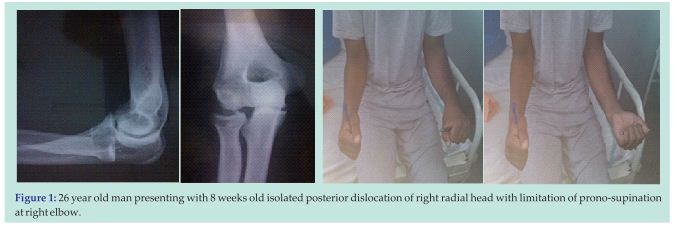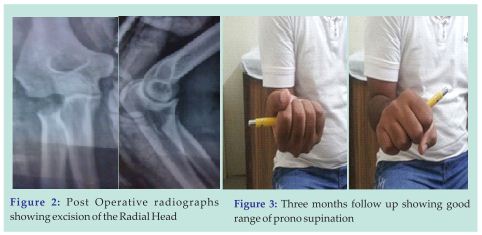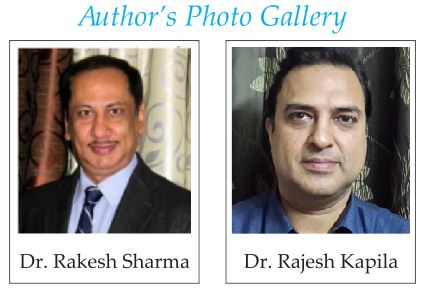[box type=”bio”] What to Learn from this Article?[/box]
Presentation and Management of a rare case of isolated radial head dislocation.
Case Report | Volume 5 | Issue 1 | JOCR Jan-March 2015 | Page 73-75 | Rakesh Sharma, Rajesh Kapila, Mannan Ahmed. DOI: 10.13107/jocr.2250-0685.261
Authors: Rakesh Sharma[1], Rajesh Kapila[1], Mannan Ahmed[1].
[1] Dept. Of Orthopaedics, Govt. Medical College, AMRITSAR, Punjab, India -143001.
Address of Correspondence:
Dr. Rakesh Sharma, 231- Green Avenue, AMRITSAR-143001, Punjab, India. E mail : drrksharma50@yahoo.com
Abstract
A 26 year old male reported with gross limitation of pronation and supination of right forearm 8 week after a vehicular accident. X- Ray of the elbow showed isolated radial head dislocation without any associated fracture. It was treated with radial head excision with almost full restoration of movements postoperatively. The case is presented because of rarity of this injury and the tendency to miss this rare injury especially in the presence of other distracting injuries. However its early diagnosis and proper management is required to prevent chronic pain in future due to ensuing osteoarthritic changes and the disability of pronation and supination.
Keywords: Radial Head, Dislocation, Pronation, Supination.
Introduction
Isolated dislocation of the radial head in adults is a rare injury with less than 30 cases reported in literature [1-9]. Most cases that are reported are diagnosed early and are treated conservatively. If neglected, these can cause restriction of forearm supination and pronation, secondary degenerative arthritis of the elbow and distal radio-ulnar joints later on. This important injury can easily be missed in the presence of other major associated injuries. Also since with this injury there is no limitation of elbow flexion-extension and limitation of prono-supination is relatively less disabling, the patient may tend to ignore the disability and present late. Lastly the mushrooming of unlawful and uncontrolled bone setters can make the simple injuries complicated and problematic later on. We present one of this rare case here.
Case report
A 26-year old man presented to us 8 weeks after injury to his right elbow with a motorbike accident. The patient complained of pain in the right elbow immediately after accident though he was able to flex and extend the elbow. Thinking it to be a trivial injury he went to a bone setter for treatment, who applied wooden splints after oil massage to the elbow. After 4 weeks the patient was asked to start his normal elbow movements. However, the patient had pain in the elbow and presented to us after further 4 weeks with gross limitation of supination and pronation. There was no previous history of elbow injury or arthritis. On examination, there was minimal swelling over the elbow and tenderness over the radial head, which appeared displaced backwards. There was a flexion attitude of the right elbow. Although he had good flexion and extension of the elbow, forearm pronation and supination were grossly restricted and painful. (Fig.5 and 6). There was no evidence of posterior interosseus nerve palsy. Radiographs showed posterior dislocation of the radial head with no associated fractures of the radius, ulna or disruption of the distal radio-ulnar joint. (Fig.1). 

Discussion
Isolated dislocation of the radial head with no other associated fracture or dislocation of elbow is rare but not unknown injury in adults is a rare injury [1-5]. This type of injury are more common in children [6]. Reduction in such cases is easily achieved by a pronation/ supination manoeuvre [2] and most authors propose immobilization of the elbow in flexion and supination in a plaster cast [6].The mechanism leading to an isolated radial dislocation has been variously described. Most authors describe an indirect mechanism. The proximal radio-ulnar joint is most stable in supination: in this position, the contact between radius and ulna is maximal and the interosseous membrane, the annular ligament, and the anterior fibres of the quadrate ligament are all taut, thus drawing the radial head snugly against its notch in the ulna, Cadaveric studies have shown that posterior dislocation of the radial head cannot occur without the rupture of the annular ligament; in addition, partial tear of the quadrate ligament and the proximal interosseous membrane takes place[7]. Most acute cases can be reduced closed and the functional outcome seems to be good post reduction. If missed or neglected, an open reduction has to be done with either an annular ligament reconstruction [3] or a radial head excision deemed as the procedure of choice [7].
In this case radial head excision was done, immobilisation carried out in POP slab in flexion & supination. The period of immobilisation was 21 days.
In the presence of major distracting injuries like long bone fractures, pelvic fractures, chest and abdominal injuries, an isolated radial head dislocation can be easily missed as pain is masked by the presence of major distracting injuries and flexion and extension of the elbow is almost normal. Even if it is an isolated injury patient may take it as a minor injury because of normal flexion and extension at elbow. Therefore occurrence of such an injury must be kept in mind in all cases of elbow trauma and supination and pronation of the forearm must be assessed. This injury if missed can have serious repercussions later on, such as degenerative arthritis of the elbow and the distal radio-ulnar joints. There is also need for awareness amongst the public about the dangers of going to bonesetters, even for small injuries after any accident.
Clinical Message
Isolated radial head fractures may present late in form of restricted prono-supination. excision of radial head offers good management strategy to regain function in these cases.
References
1. Negi AK, Pestonji MD, Iyer S. Isolated posterior dislocation of the radial head in an adult. J Postgrad Med. 1992;38:143.
2. Bonatus T, Chapman MW, Felix N. Traumatic anterior dislocation of the radial head in an adult. J Orthop Trauma. 1995;9:441–4.
3. Noyez JF. Isolated traumatic posterior dislocation of the radial head: a report of two cases. Acta Orthop Belg. 1996;62:148–50.
4. Takami H, Takahashi S, Ando M. Irreducible isolated dislocation of theradial head. Clin Orthop Relat Res. 1997;345:168–70.
5. Dhawan A, Hospodar PP. Isolated posttraumatic posterior dislocation of the radial head in an adult. Am J Orthop. 2002;31:83–6.
6. Yasuwaki Y, Itagane H, Nagata Y, Nishimoto S, Nakano A, Tanaka S. Isolated lateral traumatic dislocation of the radial head in a boy: case report. J Trauma. 1993;35:312–3.
7. Wiley JJ, Pegington J, Horwich JP. Traumatic dislocation of the radius at the J Bone Joint Surg [Br] 1974;56:501–7.
8. Ulfin Rethnam, Rajam SU Yesupalan and Salah S Bastawrous . Isolated radial head dislocation, a rare and easily missed injury in the presence of major distracting injuries: a case report. Journal of Medical Case Reports 2007,1 : 38
9. El Ibrahimi A, Shimi M, Daoudi A, Elmrini A. Isolated, traumatic posterior dislocation of the radial head in an adult: A new case treated conservatively. J Emerg Trauma Shock. 2010 Oct;3(4):422-4.
| How to Cite This Article: Sharma R, Kapila R, Ahmed M. Isolated, Traumatic Posterior Dislocation of the Radial Head in an Adult : A Rare Case Report. Journal of Orthopaedic Case Reports 2015 Jan-March;5(1): 73-75. Available from: https://www.jocr.co.in/wp/2015/01/28/2250-0685-261-fulltext/ |
[Full Text HTML] [Full Text PDF] [XML]
[rate_this_page]
Dear Reader, We are very excited about New Features in JOCR. Please do let us know what you think by Clicking on the Sliding “Feedback Form” button on the <<< left of the page or sending a mail to us at editor.jocr@gmail.com





